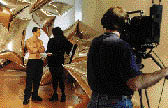
The new director of The Andy Warhol Museum, Tom Sokolowski, sees his first mission as making the Warhol an indispensable cultural outlet for that segment of the population that may be more comfortable outside the mainstream, as well as those interested in Warhol and his far-reaching influence. Sokolowski, the former director of New York University's Grey Art Gallery & Study Center, assumed his position in May.
The Warhol Museum invites a non-traditional approach to art and art museums by providing culture as a whole - rock music, poetry readings, happenings. "Art is all of a piece, and Warhol looked at it that way. A traditional museum would not be true to his mission," Sokolowski explains. Warhol, who worked with so many different media, and so many different approaches to art - silk screening, drawing, magazine production, film, in addition to painting - made the work of many other artists possible. To understand the culture of the last half of this century, and see the roots of what lies ahead, a multi-dimensional experience must take place that is more than simply walking through the galleries and looking at the walls.
Last fall, Autumn at Andy's was a four-month celebration of the fellow artists, writers, musicians, filmmakers, and performers whose work was created in the light of Warhol's talent. Events during this period included a lecture and an installation made up of toys and an antique bear trap created by Teller, the traditionally non-speaking partner in the magic/performance duo Penn and Teller; films and a lecture by Kenneth Anger, a major figure in avant-garde cinema, as well as an exhibition of selections from his personal collection of Hollywood movie memorabilia; a celebration of the traditional Mexican Day of the Dead in the museum's Skulls gallery; and, in collaboration with the Pittsburgh Chamber Music Project, a performance of Peter Maxwell Davies' Eight Songs for a Mad King, a music/theater song-cycle in which the crazed King George III tries to teach the birds to make music. Attendance during this period was close to 18,000, clear evidence that the museum has an important place in Pittsburgh's cultural community.
The Warhol museum has a prominent place in the global community as well. Andy Warhol 1956-1986: Mirror of His Time traveled to three venues in Japan, a country pivotal in Warhol's own artistic development. The show consisted of approximately 125 paintings, eight sculptures, 55 drawings, photographs, archival materials, room environments, a film program, and a full-color catalogue in English and Japanese. The 23rd Sao Paulo International Bienal included Public Faces, Private Parts: Andy Warhol's Portraits and Torsos, consisting of approximately 50 of Warhol's portrait paintings from the 1960s through the 1980s, as well as his monumental series of nude studies, the Torso paintings of the 1970s.
There are many benefits to organizing large, traveling shows. In addition to commanding a fee that supports the ongoing work of the museum, publications to accompany the exhibition are funded by the venue institutions, stretchers can be made for some of Warhol's larger works that have not been displayed before, and new audiences are introduced to the range of Warhol's work. And while the shows, which took place concurrently, involved close to 300 works of art, the walls at the Warhol remained filled, testimony to the wealth of the collection.